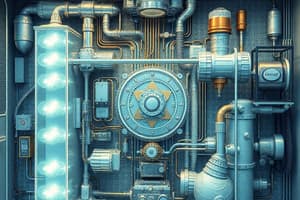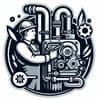Podcast
Questions and Answers
How do you call a heat exchanger in which low-pressure refrigerant boils or vaporizes?
How do you call a heat exchanger in which low-pressure refrigerant boils or vaporizes?
Evaporator
What is the name of the refrigeration system where only part of the circulated refrigerant is evaporated?
What is the name of the refrigeration system where only part of the circulated refrigerant is evaporated?
Partial Evaporator System
How do you call the ice formation on a refrigeration system at the expansion device?
How do you call the ice formation on a refrigeration system at the expansion device?
Frost
In a lithium bromide solution absorption refrigeration system, which of the following is the function of water?
In a lithium bromide solution absorption refrigeration system, which of the following is the function of water?
What do you call the pressure vessel mounted above the generator in an absorption refrigeration system?
What do you call the pressure vessel mounted above the generator in an absorption refrigeration system?
What is the inlet part of the condenser in an absorption refrigeration system called?
What is the inlet part of the condenser in an absorption refrigeration system called?
Which of the following is a scale of temperature where the melting point of ice is 0° and the boiling point of water is 80°?
Which of the following is a scale of temperature where the melting point of ice is 0° and the boiling point of water is 80°?
What is the amount of heat energy required to raise the temperature of one pound of water by one degree Fahrenheit?
What is the amount of heat energy required to raise the temperature of one pound of water by one degree Fahrenheit?
What do you call the mixtures or substances used in laboratory methods to produce a drop in temperature?
What do you call the mixtures or substances used in laboratory methods to produce a drop in temperature?
What is the maximum temperature at which any gas or vapor may be condensed into a liquid called?
What is the maximum temperature at which any gas or vapor may be condensed into a liquid called?
What is it called when a refrigerant exists as a liquid under normal atmospheric pressure and temperature but must be vaporized in an evaporator?
What is it called when a refrigerant exists as a liquid under normal atmospheric pressure and temperature but must be vaporized in an evaporator?
How do you call the group of refrigerants developed to overcome the effects of ammonia and sulfur dioxide?
How do you call the group of refrigerants developed to overcome the effects of ammonia and sulfur dioxide?
What component combines the functions of a cooling tower and a condenser in a refrigeration system?
What component combines the functions of a cooling tower and a condenser in a refrigeration system?
What factor is used in calculating the overall heat transfer through the tube walls of a condenser?
What factor is used in calculating the overall heat transfer through the tube walls of a condenser?
What type of evaporator has a tank or accumulator located above the coil?
What type of evaporator has a tank or accumulator located above the coil?
What is the standardized term for any device that meters or regulates the flow of liquid refrigerant to an evaporator?
What is the standardized term for any device that meters or regulates the flow of liquid refrigerant to an evaporator?
Define a 'control valve'.
Define a 'control valve'.
In a pneumatic temperature control system, what is referred to as the 'manipulated variable'?
In a pneumatic temperature control system, what is referred to as the 'manipulated variable'?
Which of the following valves allows fluid to pass through in one direction?
Which of the following valves allows fluid to pass through in one direction?
How do you classify a solenoid valve?
How do you classify a solenoid valve?
What is a thermostat?
What is a thermostat?
What is one of the main purposes of refractory in a boiler furnace?
What is one of the main purposes of refractory in a boiler furnace?
What type of steam trap are balance pressure traps?
What type of steam trap are balance pressure traps?
What is a characteristic feature of thermodynamic steam traps?
What is a characteristic feature of thermodynamic steam traps?
What are the main considerations for steam trap selection?
What are the main considerations for steam trap selection?
Can temperature-controlled applications be trapped?
Can temperature-controlled applications be trapped?
Flashcards are hidden until you start studying
Study Notes
Refrigeration System Components
- Evaporator: A heat exchanger where low-pressure refrigerant boils, absorbing heat from the refrigerated area.
- Flooded Evaporator: A type of evaporator with a tank or drum above the coil, keeping the inside full of refrigerant.
- Expansion Device: It controls the flow of liquid refrigerant to the evaporator.
- Condenser: A heat exchanger where the refrigerant releases heat to the surrounding environment, usually air or water.
- Cooling Tower: A type of condenser that combines the functions of a cooling tower and a condenser.
- Accumulator: In a flooded evaporator, a tank or drum above the coil.
- Control Valve: A component that meters or regulates the flow of liquid refrigerant to an evaporator.
Refrigeration Systems
- Absorption Refrigeration System: A refrigeration system where only part of the circulated refrigerant is evaporated, with the remainder separated and recirculated.
- Lithium Bromide Absorption Refrigeration System: A type of absorption refrigeration system where water is the refrigerant and lithium bromide is the absorbent.
Refrigeration System Components (Absorption System)
- Generator: A pressure vessel where the refrigerant is evaporated.
- Absorber: The component where the absorbent (e.g., lithium bromide) absorbs the refrigerant vapor.
- Condenser: The component where the refrigerant vapor cools and condenses into a liquid.
- Evaporator: The component where the refrigerant absorbs heat from the refrigerated space.
- Bubble Column: The part of the absorber where the refrigerant vapor is absorbed.
- Baffle Plate: A device used to improve the efficiency of the bubble column by creating a more turbulent flow.
Other Refrigeration Concepts
- Refrigerant: A substance that absorbs heat from a refrigerated space and releases it to the surrounding environment.
- Critical Temperature: The maximum temperature at which a gas or vapor can be condensed into a liquid, regardless of the pressure.
- Sub-atmospheric Pressure: Any refrigerant in liquid form at normal atmospheric pressure and temperature must be vaporized at a pressure below atmospheric in the evaporator.
- Synthetic Refrigerant: Refrigerant developed to overcome the toxicity and safety concerns of older refrigerants like ammonia and sulfur dioxide.
- Dirt Factor: A factor used to calculate the overall heat transfer through tube walls, accounting for dirt and foreign material buildup.
- Freezing Point: The temperature at which a liquid transitions into a solid.
- Boiling Point: The temperature at which a liquid transitions into a gas.
- Heat of Vaporization: The amount of heat required to vaporize a unit mass of a substance at its boiling point.
- Heat of Fusion: The amount of heat required to melt a unit mass of a substance at its melting point.
System Control Concepts
- Thermostat: A device that senses temperature and controls the operation of heating or cooling systems.
- Solenoid Valve: A type of valve that uses an electromagnet to control fluid flow.
- Manipulated Variable: The factor that is manipulated or adjusted to control the system.
- Control Valve: A valve used to adjust the flow of a process fluid.
- Set Point: The desired value of the controlled variable.
- Process Variable: The condition that is being controlled.
Steam System Concepts
- Steam Trap: A device that automatically discharges condensate from steam lines.
- Thermodynamic Trap: A type of steam trap that uses the thermodynamic properties of steam to operate.
- Balance Pressure Trap: A type of steam trap that operates based on the pressure difference between the steam line and the condensate discharge line.
- Refractory: A heat-resistant material used in boiler furnaces to protect the furnace lining and improve efficiency.
- Condensate: The liquid water that forms when steam condenses.
- Backpressure: The pressure opposing the flow of a fluid.
- Non-Storage Heat Exchanger: A heat exchanger that does not store heat.
Studying That Suits You
Use AI to generate personalized quizzes and flashcards to suit your learning preferences.





